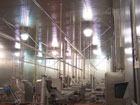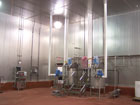Key design criteria for Fieldale Farms’ RTE facility were bio-security and food safety.

E. coli, Listeria and other nasty microbes have made big headlines this past year-and have closed the doors permanently for some processors. While best practices and employee training go a long way in reducing the number of bad bacteria, nothing assures food safety like a new plant that’s designed to eliminate microbes, minimize breeding places for bacteria and is easy to clean.
Fieldale Farms is a regional, integrated poultry processor that processes more than 3 million chickens per week for both private label and institutional customers such as food service and restaurants. The privately held company ranks 14th in size for US poultry producers, employing about 5,000 people in northern Georgia.
Fieldale’s new ready-to-eat (RTE) plant in Gainesville, GA, sparkles with all the features necessary to keep microbes out. Dr. Dan White, Fieldale’s Quality/Food Safety Manager, says that bio-security and food safety were the overriding concerns during project planning. A particular challenge involved minimizing the potential for cross-contamination when both a raw process and a fully-cooked process is being done under the same roof. “The solutions,” says White, “were engineered into the building and involved the design of the air flow; strategies for personnel and product movement; and the types and locations of maintenance areas, walls, separate drainage systems and veneers to emphasize food safety and bio-security.”
Fieldale needed an engineering firm and project/construction management team that could handle its specific challenges. Vaughn, Coltrane, Pharr and Associates (VCP&A) and its sister company, KCV Construction Services Inc., won the project in December of 2004, because, for them, designing and building an RTE plant based on bio-security and food safety were not new concepts. VCP&A designed six RTE plants in the last three years, and KCV had managed three RTE projects in the last five years.
Getting started
Fieldale’s Gainesville site already had a par-fried/cooked facility in operation since 1984. The object was to connect the new 190,000-sq.-ft. RTE facility to the existing 90,000-sq.-ft. building, while at the same time, overcoming some basic problems.
According to Plant Manager Jody Howell, the company had both a five-year and a 10-year expansion plan that called for a new production line in Phase 1 that could handle both breaded and non-breaded RTE products. Phases 2 and 3 represented new production facilities, each in separate rooms, to be implemented according to the plans-or sooner, according to customer demands. Howell followed some good advice from the engineering firm: Set up the rooms for Phases 2 and 3 to be ready for the new equipment now, thereby saving time and money when it’s time to install new process lines.

Designed for food safety
According to Dr. White, “We do microbe testing on all our RTE products and hold them in the freezer until we get the results back from the lab. Testing every lot provides the highest level of assurance for our products.” But this commitment to quality control requires holding food for four days.
The engineering firm placed a 28°F centralized raw product cooler between the original facility and the new cooking facility. In addition, a portioning and sizing room was developed to supply both facilities as well as outsourcing for other plants. These areas will also service the future cooked lines. The portioning and sizing room houses the latest water jet cutting systems based on vision technologies.
The entire second floor, which is used for storing ingredients over the raw end of the process and dry packaging materials over the finished-product side, is environmentally conditioned and process-cleanable. With food safety being a consideration, all boxes erected on this floor are automatically conveyed to the bag-to-box area.
A walkable ceiling utility space area (USA) is located above the production area and below the second floor. Above the ceiling are the piping, electrical and communications distribution systems. The USA allows piping, ducting and conduits to be run horizontally-sealed away from the processing areas by isolated metal panels. Locating pipes in this space also prevents fluids (e.g., hydraulic) from getting into the process area, should a line break. In addition, only vertical runs to the process area are allowed, making clean-up relatively easy because there are no horizontal surfaces where dirt and microbes can accumulate.
The process area walls are all food-grade stainless steel, and the 1/4-inch-per-foot sloping floors are epoxy surfaced, making them easy to clean. All bollards, doors, door frames, clean-up station racks, sinks, etc. are also fabricated from stainless steel. Rather than having a problematic, germ-harboring seam between the floor and walls at the floor level, solid two-ft. curbs were designed so that the joint between the floor and walls is two feet from the floor. This, according to Howell, makes the cleaning process much easier. In addition, the drains from the cooked side and the raw side run separately as they exit the facility, minimizing the possibility of bacteria from the raw side of the process entering the cooked side, should there be a reverse of flow.
To further separate the two sides of the process, floors are color-coded red in the raw area and blue in the cooked area, with each area having separate employee entrances, break rooms and locker rooms. Positive air-flows cleaned by HEPA filters keep microbes and other contaminants from entering both the second-floor storage areas and the live process areas. There are also two completely separate chemical supply rooms for cleaning-one for each side of the process.
Utilities handy, but out of the way
Utilities for the plant include electrical power distribution, a thermal fluid heat transfer system, a steam system for product humidification, process hot water, oil-free compressed air, two large hydraulic systems, a high-pressure water clean-up system and a 1,300-ton ammonia refrigeration system. Some of these systems are located on the roof to minimize energy loss through long runs; for example, heat exchanges that use thermal fluid are located on the roof.
The refrigeration plant is located on the ground floor, but in an exterior room to the processing area, meeting employee safety regulations. The ammonia system provides space cooling, chilled water, product cooling and freezing.

Expert team
Fieldale assembled an expert team of equipment vendors, engineers and its own personnel, including food scientists, food safety experts and quality control engineers to design a process that conformed to the highest level of quality and food safety standards. Howell explained that although having employees involved in the planning was important, it wasn’t necessary for all of them to attend weekly meetings. But when it came to the design and layout of the equipment, plant floor operators as well as managers, maintenance staff and engineers were asked for their ideas.
This first line can process up to 10,000 lbs. of breaded or non-breaded RTE chicken per hour, or 6,000 lbs. per hour for specialized product categories. Either process begins with a recipe-based brine mix system, which is then blended with the raw product in vacuum tumblers. Next, the product is directed to either the roasting line or the breading line before entering the oven. Currently, roasted and breaded products are not produced simultaneously; the roasting line consists of line feed systems, grilling equipment and two-sided char marking, while the breading line consists of multiple pass breading and batter equipment, vibratory flow conveyance and a pre-cooking fryer.
Using portable conveyance, either line then feeds into a spiral oven. Meat stripping/cutting equipment using advanced water jet technology sizes and cuts the meat as necessary before it enters the spiral freezer, located just 20 ft. away, which, according to White, has a distinct advantage over circular blade cutters. A water jet system always uses a fresh stream of water to cut meat whereas, in a metal-based cutting system, the knife comes in contact with successive pieces of meat making it easier for pathogens to spread.
After the product leaves the spiral freezer, it goes through a metal inspection system set to its highest sensitivity. If the detection system reads positive, the product is rejected, and this activity is recorded in software. After successful inspection, the product is weighed and packaged; after the packaging operation is complete, the product is again screened by an inline metal detection system and then sent to a checkweigher prior to boxing and palletizing.
Further safety checks
In addition to screening for metal contamination, the process control system monitors critical temperatures prior to freezing and storing. Storage temperatures are monitored, and X-ray technologies are used on the raw side of the process-not so much to check for glass, but to check for bones and cartilage. For some products, X-ray technology is also used prior to the marination process to check for bones.
Glass should not be a problem as long as appropriate safeguards are taken. Howell notes that in addition to special light fixtures and windows with shatter-proof protection, employees are subjected to a “no-glass” policy-except for eyeglasses.
Matrix quality workstations monitor inspections and critical process temperatures, providing Howell and the operators with a real-time glimpse into the process. The system can track incidences, analyze them and provide real-time statistical process control capabilities. This data is integrated with Fieldale’s IBM AS-400 based shipping and inventory control system for product traceability.
The new facility was started up in October, 2006-one year and one week after the foundation was begun. In addition to construction of the facility, KCV managed the equipment installation as well as the start-up. Full production was achieved the first week of operation with only minor issues encountered in the packaging system.
The success of the project can be attributed to the teamwork exhibited by all the participants, enhanced by 3-D CAD software in the project delivery system used by VCP&A and KCV. According to VCP&A’s Principal William O. Vaughn, “The project delivery system was most unique. It allowed Fieldale Farms to participate in decisions on vendors, contractors, schedules, quality of construction and project cost.” The facility was designed in 3-D, Vaughn said. Construction documents were extracted from the 3-D model, thus allowing for identification of conflicts and errors. “The database design program allowed for constant monitoring of construction materials and construction progress. Fieldale was constantly aware of the project cost, which allowed informed decisions on scope changes and the impact of those changes on cost and schedule,” he said.

